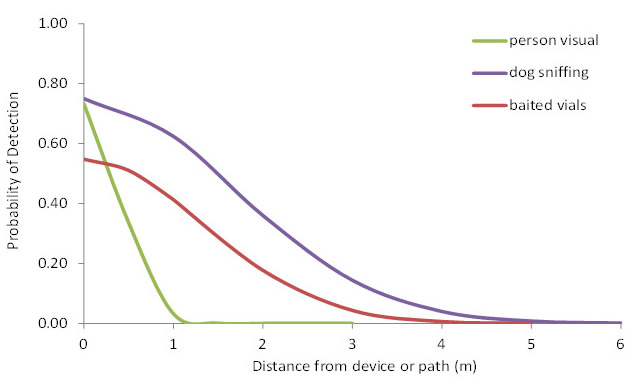Using surveillance models to provide confidence in the eradication of Argentine ants

Argentine ant. © Richard Toft, Entecol
Surveys undertaken near the end of an eradication programme will often not find any target pests and the search results will consist of many zeros. But how do we know those zeros are real and there really are no pests left? Maybe some individuals have survived control but haven’t been detected because they are so rare, and/or the search effort was insufficient to find them.
Some eradication programmes declare ‘success’ after a certain time interval during which the pest has not been found (e.g. 2 years). However, relying on a certain period is not useful unless the surveillance effort required to find a pest when at low density is specified. It is easy to find nothing when only a few surveys are undertaken, or when only part of the area is searched.
To answer the ‘Are they true zeros?’ question, surveillance sensitivity must be quantified in terms of the probability of detecting an organism if present. With this information managers can estimate the probability that eradication has been achieved and thus avoid prematurely declaring success due to insufficient survey effort, or, conversely, avoid wasting resources on surveys when the pest has already been eradicated.
Darren Ward, Mandy Barron and Dean Anderson applied these concepts to the eradication programme for Argentine ants, Linepithema humile, on Kawau Island. Ants are recognised globally as significant exotic invaders. However, until recently relatively little had been published on the detectability of invasive ants, despite them being prone to poor detection because of their small size, variable foraging habits, cryptic nature, and strong association with human transportation. One species, the Argentine ant, is highly invasive and has been accidentally introduced by human trade to many countries throughout the world. They have invaded numerous open-canopy habitats, including coastal sage scrub and riparian woodland in California, matorral in Chile, fynbos in South Africa, subalpine shrubland in Hawaii, and oak and pine woodland in Portugal. Argentine ants are well established in northern New Zealand and are found in many types of open-canopy habitats, especially coastal ones, and increasingly on off-shore islands.
Darren and his colleagues used the spatially explicit surveillance data model developed by Dean and other colleagues to estimate the probability that Argentine ants had been eradicated from the Schoolhouse Bay area on Kawau Island in the Hauraki Gulf. This model quantifies the sensitivity of each search method using a maximum probability of detection parameter (assumed to be when the target pest is directly on the search path or at the detection device) and a spatial decay parameter describing the decline in detection probability with increasing distance from the device or searcher.
All search paths or device locations are used to calculate a combined probability of detection for that survey (i.e. the surveillance sensitivity) and a map of the surveillance coverage is produced. Each time a survey is done the surveillance sensitivity estimate is used to update the probability of ant eradication derived from the previous survey. For the very first survey a ‘prior’ probability of the ants being eradicated is derived from expert opinion or is left deliberately vague (e.g. ‘likely to be somewhere between 20% and 80%’.

For the Kawau Island ant eradication project there were four surveys following the spring 2012 poisoning of ants in the 3 ha of infested area at Schoolhouse Bay. Three surveillance methods were used for these surveys: visual searching, vials baited with non-toxic Inform bait, and a sniffer dog trained by Auckland Council. Several ‘paths’ were used to cover the entire Schoolhouse Bay area. These paths were documented with a GPS and used for all three surveillance methods. The spatial sensitivity parameters used are shown in Figure 1, with a sniffer dog having a greater search range than a human visually searching. A map of surveillance sensitivity for the combined methods of human searching, baited vials, and sniffer dogs is shown in Figure 2.

No Argentine ants have been detected at Schoolhouse Bay since the control operation in 2012. The estimated probability of eradication (POE) increased sharply as each survey was conducted. Analysis of the four post-control surveys estimated a median probability of eradication of 96% with a high level of confidence in the POE result. Sniffer dogs gave the highest probability of detection per path searched, and so the predicted number of surveys to reach a threshold POE of 95% was less using this survey method than with the other two methods.
Combined modelling of all surveys and sampling devices indicates there are several small spatial gaps that have received less survey effort. Such gaps might be a refuge for a small Argentine ant population. These gaps are generally on the north-facing slope behind the local residences and will be targeted for surveillance in future monitoring. Such spatially explicit models are vital to give confidence in eradication programmes, especially from highly valued conservation areas such as offshore islands.
This work was supported by the Auckland Council, the Northland Regional Council, and the Ministry of Business, Innovation Employment through funding of the Managing Invasives Portfolio at Manaaki Whenua – Landcare Research.
Darren Ward
wardd@landcareresearch.co.nz
Mandy Barron
Dean Anderson
